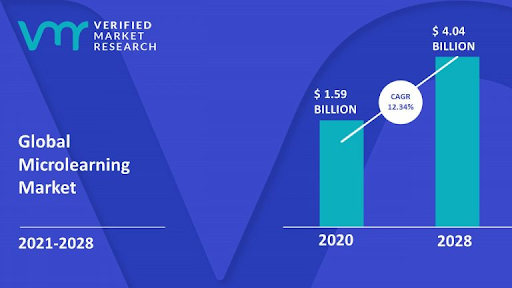
Moonpreneur
Bite-sized Learning is a self-explanatory word. It suggests breaking up e-learning materials into small snippets or chunks. It is also known as microlearning. In layman’s terms, content is “chopped” into small pieces and presented to learners who find it easier to understand and grasp.
Today these bite-sized e-learning modules are fast gaining pace. Individuals are turning more towards these short-spanned modules instead of wholesome, full-scale courses. You can gauge the growing popularity of microlearning from the fact that its market size was valued at $1.59 billion in 2020 and is projected to reach USD 4.04 billion by 2028.
Recommended Reading: Supplemental Learning for Kids: Everything You Need to Know!

Source: Verified Market Research
Difference between Bite-sized Learning and Conventional e-learning
The significant difference from conventional e-learning is the short time span to exhort the sorted and much-needed information. Bite-sized modules are short and focused. Its minimum length is two and maximum fifteen minutes, compared to the thirty to sixty minutes of conventional learning materials.
Recommended Reading; Top Benefit of Virtual Learning For Kids
This type of learning can extend up to three hours also. In the wake of shorter digital content, Microlearning is more specific and enhances the efficacy of the learner.
Benefits and Importance of Bite-sized Learning:
1. Boosts Retention: Bite-sized learning is not the real end of knowledge, but it is a great way to present the content effectively. The small snippets are more specific and relevant, thus, easier for learners to retain information. Hermann Ebbinghaus, the inventor of “the forgetting curve”, illustrates that only 21% of information is retained by learners in a month.
It highlights that a small piece of information with a repetitive approach is easier to retain. Micro-learning focuses on one or two specific topics, making it easier for the audience to digest the information easily.
Recommended Reading: Nano Learning Is The Way Forward
2. Relevance and Flexibility: Modern learners are short of time. So, microlearning is the need of the hour. Bite-sized learning fits easily into the busy schedule of the learners. Job-oriented content provides the learner with the required knowledge right away. Full course modules exhaust a lot of energy and time in the capacity of hard work and dedication-which makes it difficult to justify your job.
Nothing can be more convenient than learning anywhere and anytime. The flexibility of microlearning is a great option instead and benefits the learner while catering to their immediate need. They can go through the various snippets on the mobile. Ten to fifteen minutes of learning modules are more specific and meaningful while on the move, commuting to work, or at a time suitable for the learner.
Recommended Reading: Experiential Learning: How it Helps Learn and Retain Knowledge
3. Higher Engagement of Attention: Microlearning aims to engage the learners with just one or two specific topics relevant to their needs. Today’s learners are more attracted to personalized content which can help them in their moment of need. They primarily do workplace learning on smartphones, etc.
Instead of pulling through this tedious session of one or two hours, people jump to micro-learning tips where meaningful and concentrated subject matter is present. A ten minutes video is more appealing than a sixty or seventy-minute lecture packed with a lot of variant information.
It is convenient for the learners to go through the topic more than once and more to keep them interested. Apart from being informative and compact, the small nuggets are very much accessible for a quick refresher course as well.
Tips for creating Bite-sized Learning
After getting positive reinforcement on the importance of bite–sized learning, the next question arises how to create effective micro-learning tips.
1. Stick to specific content: Bite-sized learning specifically means delivering relevant content in small pieces, avoiding unnecessary information. One or a maximum of two topics is sufficient for presentation instead of pulling through the whole course of content. It is easy to retain by the learner.
2. Recapping through fun games: Quiz and games stimulate learners’ capability. A simple test or a quiz can help learners to identify their weak points. This setup also deviates from monotonous long lectures and keeps the participants engaged and interested. One can always seek more to satiate the hunger for knowledge.
Try Moonpreneur Career Quiz!
3. Masterclasses on Microlearning: Masterclasses with small demo clippings and tips by experts can be a great menu to cater to the needs of the modern learner.
4. Create mini-courses: Nowadays, learners lap up small courses which they can complete in a short time. They are cost-effective, and it’s a win-win proposition. Multi-tasking has become a way of life, and it is appreciated if one can fit these mini-courses along with other jobs. Learners get a sense of accomplishment with these microlearning courses.
Conclusion
So, we can safely conclude here that bite-sized learning is one of the most convenient and adaptable ways of learning for the modern learner, even though we cannot negate the importance of full-time courses.
Moonpreneur is on a mission to disrupt traditional education and future-proof the next generation with holistic learning solutions. Its Innovator Program is building tomorrow’s workforce by training students in AI/ML, Robotics, Coding, IoT, and Apps, enabling entrepreneurship through experiential learning.

























